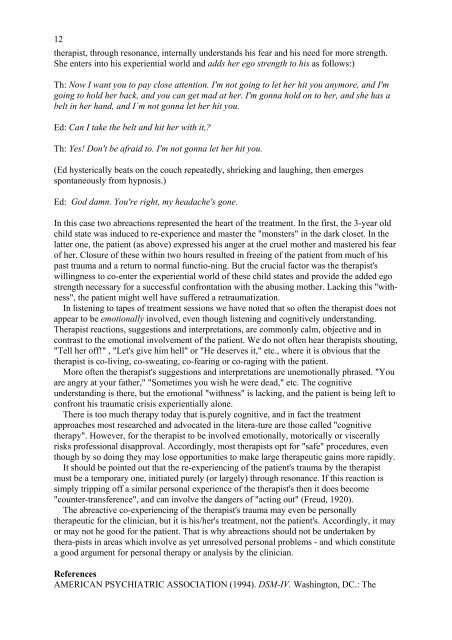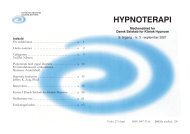HYPNOTERAPl - Dansk Selskab for Klinisk Hypnose
HYPNOTERAPl - Dansk Selskab for Klinisk Hypnose
HYPNOTERAPl - Dansk Selskab for Klinisk Hypnose
Create successful ePaper yourself
Turn your PDF publications into a flip-book with our unique Google optimized e-Paper software.
12<br />
therapist, through resonance, internally understands his fear and his need <strong>for</strong> more strength.<br />
She enters into his experiential world and adds her ego strength to his as follows:)<br />
Th: Now I want you to pay close attention. I'm not going to let her hit you anymore, and I'm<br />
going to hold her back, and you can get mad at her. I'm gonna hold on to her, and she has a<br />
belt in her hand, and I´m not gonna let her hit you.<br />
Ed: Can I take the belt and hit her with it,?<br />
Th: Yes! Don't be afraid to. I'm not gonna let her hit you.<br />
(Ed hysterically beats on the couch repeatedly, shrieking and laughing, then emerges<br />
spontaneously from hypnosis.)<br />
Ed: God damn. You're right, my headache's gone.<br />
In this case two abreactions represented the heart of the treatment. In the first, the 3-year old<br />
child state was induced to re-experience and master the "monsters" in the dark closet. In the<br />
latter one, the patient (as above) expressed his anger at the cruel mother and mastered his fear<br />
of her. Closure of these within two hours resulted in freeing of the patient from much of his<br />
past trauma and a return to normal functio-ning. But the crucial factor was the therapist's<br />
willingness to co-enter the experiential world of these child states and provide the added ego<br />
strength necessary <strong>for</strong> a successful confrontation with the abusing mother. Lacking this "withness",<br />
the patient might well have suffered a retraumatization.<br />
In listening to tapes of treatment sessions we have noted that so often the therapist does not<br />
appear to be emotionally involved, even though listening and cognitively understanding.<br />
Therapist reactions, suggestions and interpretations, are commonly calm, objective and in<br />
contrast to the emotional involvement of the patient. We do not often hear therapists shouting,<br />
"Tell her off!" , "Let's give him hell" or "He deserves it," etc., where it is obvious that the<br />
therapist is co-living, co-sweating, co-fearing or co-raging with the patient.<br />
More often the therapist's suggestions and interpretations are unemotionally phrased. "You<br />
are angry at your father," "Sometimes you wish he were dead," etc. The cognitive<br />
understanding is there, but the emotional "withness" is lacking, and the patient is being left to<br />
confront his traumatic crisis experientially alone.<br />
There is too much therapy today that is.purely cognitive, and in fact the treatment<br />
approaches most researched and advocated in the litera-ture are those called "cognitive<br />
therapy". However, <strong>for</strong> the therapist to be involved emotionally, motorically or viscerally<br />
risks professional disapproval. Accordingly, most therapists opt <strong>for</strong> "safe" procedures, even<br />
though by so doing they may lose opportunities to make large therapeutic gains more rapidly.<br />
It should be pointed out that the re-experiencing of the patient's trauma by the therapist<br />
must be a temporary one, initiated purely (or largely) through resonance. If this reaction is<br />
simply tripping off a similar personal experience of the therapist's then it does become<br />
"counter-transference", and can involve the dangers of "acting out" (Freud, 1920).<br />
The abreactive co-experiencing of the therapist's trauma may even be personally<br />
therapeutic <strong>for</strong> the clinician, but it is his/her's treatment, not the patient's. Accordingly, it may<br />
or may not he good <strong>for</strong> the patient. That is why abreactions should not be undertaken by<br />
thera-pists in areas which involve as yet unresolved personal problems - and which constitute<br />
a good argument <strong>for</strong> personal therapy or analysis by the clinician.<br />
References<br />
AMERICAN PSYCHIATRIC ASSOCIATION (1994). DSM-IV. Washington, DC.: The














